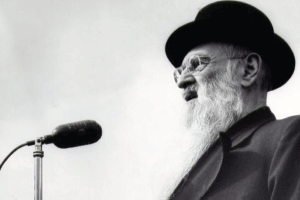The triumph of Rav Mottel Katz
| December 3, 2014
While destruction rained down on Europe, Rav Mottel Katz and his brother-in-law Rav Elya Meir Bloch were driven to rebuild their yeshivah on American soil — even as their families were decimated in the inferno. Rav Mottel, whose 50th yahrtzeit is this week, didn’t speak a word of English, yet managed to replant black-on-white yeshivah life in a red, white, and blue world
Four long years they lived with the agony of silence. Were their families dead or alive? Ignorance leaves room for hope, but even that glimmer was shattered forever in the winter of 1945 — when in one horrific moment the two roshei yeshivah found out that all had been destroyed. Rav Chaim Mordechai Katz’s wife and ten children, Rav Eliyahu Meir Bloch’s wife and three of his four children — murdered by the Nazis ym”sh beginning on the 20th of Tamuz 5701 (1941). Lesser people might have been paralyzed, permanently shattered. In fact, the co-roshei yeshivah and brothers-in-law did not speak of the tragedy publicly for a year and a half. Their silence was understood by all as an eloquent expression of vayidom Aharon (Vayikra 10:3). They were building Torah in America and hespedim at that time would have been too emotionally disabling. So they waited until the summer of 1946 to speak of their personal cataclysm.
This was the leitmotif of Rosh Yeshivah Rav Mottel Katz, as he was lovingly called by all. And 50 years after his passing on 12 Kislev 5724 (1964), that sense of achrayus — that total devotion to Klal Yisrael regardless of unspeakable personal suffering — still reverberates among the Telshe talmidim whose lives he touched during the years of struggle and growth.
The Early Years
Reb Mottel was only a child when he got his first badge-of-honor nickname — Mottel Populaner — after his father, noted talmid chacham, Reb Yaakov, and his mother, Rochel (nee Hovshas), moved to the village of Populana. When he became a bit older, his parents sent him to the nearby city of Shaduvah, to learn in the yeshivah of the local rav. This would prove to be one of the turning points in Reb Mottel’s life, since that rav was Rav Yosef Leib Bloch, later becoming famous as the Maharil Bloch — who eventually became the rav and rosh yeshivah of Telshe. Even when Reb Mottel’s parents moved to South Africa, he stayed back, electing to remain with his lifelong rebbi, the Maharil Bloch.
When the Maharil’s father-in-law Rav Eliezer Gordon — the rosh yeshivah of Telshe — passed away in 1910, the Maharil moved to Telshe to take his place. Reb Mottel, then a 16-year-old bochur, followed his rebbi, and a few years down the line the Maharil chose him as a son-in-law for his accomplished daughter Perel Leah.
Soon Reb Mottel — a young but highly acclaimed talmid chacham — was giving shiurim to the younger talmidim in Telshe, who all clamored to learn from his wide-ranging knowledge and original thoughts. This endeavor was so successful that the Maharil instituted a four-year mechinah which Reb Mottel headed and taught the highest fourth shiur. In 1921, the Maharil founded a girl’s high school called Yavneh, which was headed at the outset by Reb Mottel himself. The yeshivah then founded a kollel, also under Reb Mottel’s leadership, which produced some of Lithuania’s greatest rabbanim. This early multitasking foreshadowed Reb Mottel’s later incredibly varied responsibilities in both Telshe and the wider Torah world.
At this point, the tragic side of Reb Mottel’s life began. On the seventh of Cheshvan 5630 (1930), Reb Mottel suffered the loss of his rebbi and beloved father-in-law, the Maharil. Soon thereafter, his own father, his beloved Rebbetzin Perel Leah, and their six-year-old son Shmuel also passed away. But instead of crumbling under the pain of crushing bereavement, Reb Mottel redoubled his efforts for Torah. In 5632 (1932), he helped to found the Tzeirei Agudas Yisrael of Lithuania and became deeply involved in the work of the Knessiah Gedolah. He soon married Chaya, the daughter of Rabbi Moshe Kravetz — the rav of Piura and a brother-in-law of the Maharil. Together they were blessed with seven children, in addition to the three remaining children of his first marriage.
Now that much of the yoke of both the spiritual and material wellbeing of the yeshivah was largely resting upon his shoulders, he would travel to America and other locations, including South Africa, to raise funds. Through these efforts, Reb Mottel helped to build up the yeshivah into a fortress of Torah with 380 students.
Oops! We could not locate your form.

